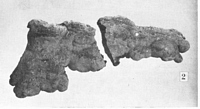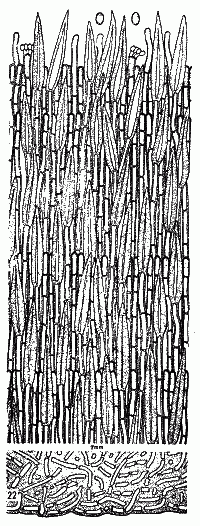|
 Hymenochaete unicolor Hymenochaete unicolor
SynonymsHymenochaete lignosa
BiostatusPresent in region - Indigenous. Non endemic
Images (click to enlarge)
Caption: Pl. 2, fig. 2. Hymenochaete lignosa G.H.Cunn. x 2/3. Specimen has been fractured to show
depth of the context. | 
Caption: FIG. 22. Hymenochaete lignosa G.H.Cunn. Transverse section x 500; spores x 1000. |
Article: Cunningham, G.H. (1957). Thelephoraceae of New Zealand. XIV. The genus Hymenochaete. Transactions of the Royal Society of New Zealand 85(1): 1-51.
Description: Hymenophore resupinate, perennial, stratose, woody and indurated, adnate, effused forming
irregular linear areas to 10 x 4 cm. Hymenial surface even, finely floccose, umber, black and
shining where rubbed, each layer tending to recede slightly, not creviced; margin dark umber,
almost black, cliff-like, to 10 mm thick, often striated with parallel bands representing lateral
margins of the strata, coarsely lobed. Context umber, to 10 mm thick, showing irregular
parallel growth zones, brittle, hard and indurated like the stroma of a Hypoxylon, composed
of many parallel layers of overlapping setae (sometimes with bands of context hyphae
between) and mainly upright hyphae compacted and cemented, towards the base context
hyphae cemented into a fuscous amorphous tissue; hyphal system monomitic; generative
hyphae 4-5 µ diameter, walls 0.5-l µ thick, golden brown, freely branched and septate. Setal
layers overlapping and poorly defined, to 80 µ deep, some demarked by persistent palisades
of paraphyses or context hyphae; setae projecting to 30 µ, narrowly fusiform, 32-55 x 6-8 µ,
larger in the context, walls naked, bright reddish-brown, lumina narrow. Hymenial layer a
scanty palisade of basidia, paraphyses and scattered paraphysate hyphae. Basidia subclavate,
12-16 x 4-4.5 µ, 4-spored; sterigmata slightly arcuate, slender, 4-5 µ long. Paraphyses
cylindrical or subclavate, tinted, about the same diameter but narrower than the basidia.
Paraphysate hyphae slightly projecting, coloured, filiform, sometimes branched near apices.
Spores elliptical with rounded ends, apiculate, 4-4.5 x 2.5-3 µ, walls smooth, hyaline, 0.1 µ
thick.
Habitat: HABITAT: Adnate on decorticated decaying trunks; type of rot not seen.
Distribution: DISTRIBUTION: New Zealand.
Notes: Specimens resemble in colour and external appearance stromata of certain species of
Hypoxylon. Plants may attain a thickness of 10 mm, are woody and brittle, and break with a
clean fracture, exposing parallel growth lines. Sections show them to be composed of
overlapping rows of setae embedded in upright cemented hyphae, with a thick base of hyphae
cemented into an amorphous tissue. The abhymenial surface is glabrous, polished where free
from wood debris, and without abhymenial hairs. Strata are evident in some sections, being
demarked by persistent layers of paraphyses or intertwined context hyphae; in others they
may not be visible or be indicated only by darker parallel colour zones. Setae are closely
arranged, usually possess narrow lumina and those projecting may become enmeshed within
hyphal sheaths. Only a few spores were found attached to basidia. These were elliptical with
rounded ends. A few suballantoid spores were seen floating in the mountant, but none of this
shape was found attached, so they may have been contaminants.
Article: Cunningham, G.H. (1963). The Thelephoraceae of Australia and New Zealand. New Zealand Department of Scientific and Industrial Research, Bulletin 145: 359 p. Wellington:.
Description: Hymenophore resupinate, perennial,
membranous, brittle, adherent, at first appearing as numerous orbicular colonies
2-15 mm across, soon merging to form linear areas to 12 x 3 cm; hymenial surface
cinnamon, deeply irregularly areolately creviced, tending to lift at edges of
crevices; margin thinning out, fulvous, fibrillose, adherent. Context
ferruginous, 400-650 µm thick, of many irregular rows of overlapping setae
embedded among erect, closely compacted hyphae, sometimes with a narrow zone of
intertwined hyphae of deeper colour in the base of the abhymenial region;
generative hyphae 3-4 µm diameter, walls 0.5 µm thick, yellow brown. Setae
scattered in irregular rows through the context, subulate, some projecting to 35
µm, 40-60 x 5-7 µm, walls naked, reddish-brown, lumena narrow. Hymenial layer to
30 µm deep, a close palisade of basidia, paraphyses, and paraphysate hyphae.
Basidia subclavate, 12-16 x 4-5 µm, bearing 4 spores; sterigmata slightly
arcuate, slender, to 5 µm long. Paraphyses subclavate or cylindrical, 6-10 x
3.5-4 µm. Paraphysate hyphae abundant or scanty, projecting to 25 µm, filiform,
hyaline. Spores elliptical, 4.5-5.5 x 3-3.5 µm, walls smooth, hyaline, 0.1 µm
thick.
Habitat: HABITAT: Bark or decorticated wood of dead branches or
leaf bases associated with a pocket rot.
Distribution: DISTRIBUTION: West Indies, South America, Australia, New Zealand.
Notes: In
microfeatures specimens agree with the type collection in Kew herbarium, ex
"Cuba, Wright, No. 541". They differ somewhat in size and colour of
fructifications. The context is composed of overlapping rows of setae embedded
among compact erect hyphae, with the abhymenial layer of intertwined hyphae more
deeply coloured and compacted. Colour of the hymenial surface resembles that of
H. cinnamomea and H. rhabarbarina. From these H. unicolor
differs in that setae are slightly shorter and arranged in overlapping rows
and, although stratose, layers are indicated by dark parallel lines and not by
zones of context hyphae. Spores also differ in shape.
|